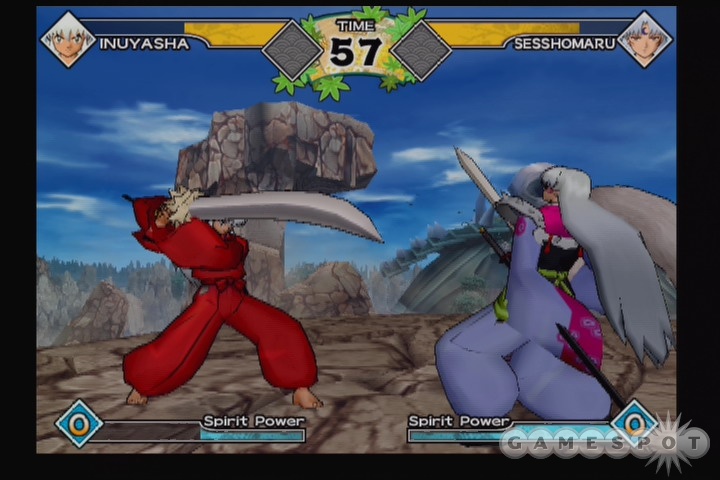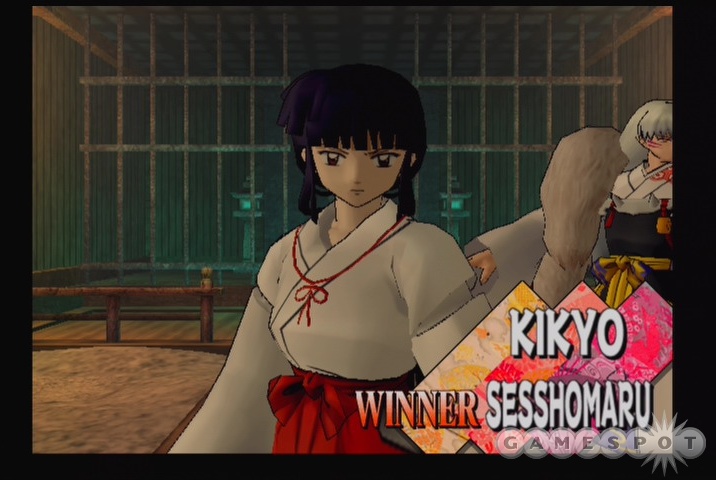Your mother might have told you that violence never solved anything, which makes it quite obvious that your mom isn't one of the creative forces behind Bandai's wildly popular anime series, Inuyasha. Inuyasha is like a more supernatural version of Dragon Ball Z set in feudal Japan. The characters aren't too familiar with the concept of "conflict resolution," and they aren't gun-shy about using force, even against allies. This predilection toward perpetual combat is harnessed nicely in Inuyasha: Feudal Combat. This simple beat-'em-up is more than happy to indulge fans, and it's got enough flash to keep the more casual players engaged. However, for those looking for more than a passable use of an anime license will likely be put off by the game's monotonously simplistic action.

Inuyasha, who himself is a half-man, half-demon, lives in a mystical world where being a half-man, half-demon doesn't seem particularly odd--at least not when your traveling companions include a young fox demon; a junior high school girl who is the reincarnation of a priestess who imprisoned you inside a tree 50 years earlier; a young female exorcist armed with the world's most comically sized boomerang; and a lecherous sorcerer with a wind tunnel in one of his hands. The relationships and character origins aren't so complex or particularly vital to the gameplay, so you could get by without already being familiar with the material. But if you're not coming into Inuyasha: Feudal Combat in hopes of getting to control some of your favorite anime characters in battle, you're pretty much missing the point.
The combat itself is akin to free-for-all brawlers like Capcom's Power Stone or Nintendo's Super Smash Bros. series, though unlike those games, there's little below the surface here to reward players who play intelligently versus those who just jam on the buttons as fast and as hard as they can. Each character handles a little bit differently, but for the most part, the same button combos will work regardless of who you're playing as, which eliminates the need to explore the abilities of each individual character--just pick who you like and mash away. It's all reasonably responsive, but since there's not much skill involved in the action, who really cares? The unique angles that Inuyasha does take on, such as the artificial intelligence ally that will fight alongside you during most of the game, are squandered because of the simple combat system.
The focus of the single-player game lies in the story mode, which actually includes four different stories, each of which puts you in control of a different character. Initially you'll play as Inuyasha, and once you complete his story you'll unlock an episode featuring Inuyasha's travel companions, Miroku and Sango. This gives way to a story focusing on Inuyasha's antagonistic, full-demon brother, Sesshomaru. Finally, you can unlock a story where you play as Shippo, the pint-sized fox-demon, whose fighting abilities are well outstripped by his enthusiasm and whose story is more of an inside joke for Inuyasha fans. Though based on the underlying characters and relationships of the show, the stories are frankly much too condensed for their own good, usually consisting of about a half-dozen different confrontations, and ending in well under half an hour.
Once you've banged through the entire story mode in an hour or two, there are a few more modes to explore. The other big single-player option is the mission mode, which strips away the story elements from the action and puts the focus on winning matches while simultaneously meeting additional criteria. The challenges here include keeping an AI partner alive, destroying a number of objects in the environment, or finishing the fight with a specific move. It's inherently more challenging than the story mode simply because you're often charged with using a specific technique rather than just mashing wildly on your controller. You can also play against a friend or an AI opponent in the straight-up battle mode, though strangely, support for four-player action is missing, even though most of the arenas are built with four characters in mind.

The relatively shallow, unrewarding gameplay experience is propped up by presentation that exhibits much more polish. From the menus to the sound design, the game is infused with a convincing feudal Japanese flavor, but it does so without feeling too heavy-handed. The character models are well detailed and feature some decent cel-shading and plenty of smooth, character-specific animations. The special attacks look good and capture that over-the-top anime vibe, though they can become repetitive. Repetition is also an issue in the sound design. The sword-clashing and various combat sounds are authentic enough, and the voice cast of the US version of the anime puts in some good work. But characters have a habit of repeating specific lines whenever they perform specific attacks, which becomes tiresome quickly.
That Inuyasha: Feudal Combat isn't really well-suited for those who haven't already invested themselves in the characters of the anime and/or manga isn't too surprising. But, with the precedent set by Atari's increasingly enjoyable Dragon Ball Z: Budokai series, it's still a disappointment. If you are a fan, you can pick this up and probably enjoy yourself at least for a while, though at some point you should ask yourself if it's worth holding out for something better.